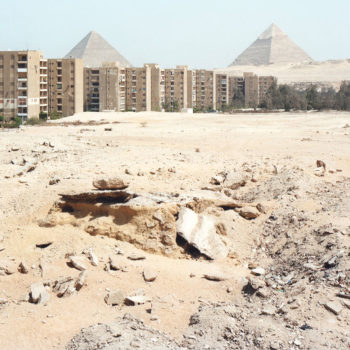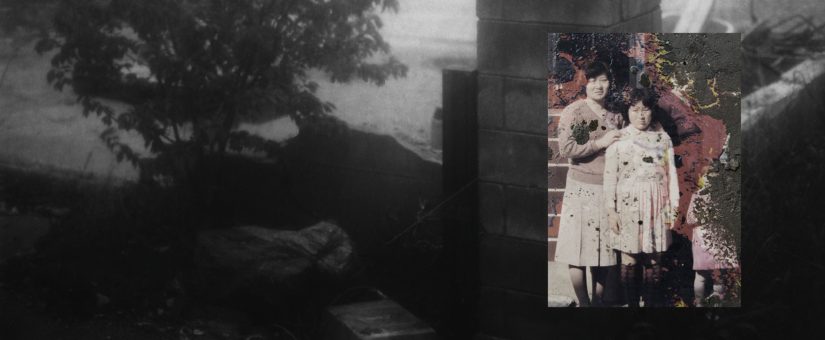
Il potere dei ricordi | Intervista a Mayumi Suzuki
Scroll down for the English version
Mayumi Suzuki è l’autrice del libro “The Restoration Will” (CEIBA, 2017) e della omonima mostra che inaugurerà a Spazio Labo’ il 9 marzo 2018. “The Restoration Will” è un progetto di ricostruzione e rinascita che Mayumi ha intrapreso nel 2011, a seguito del devastante tsunami che flagellò le coste del Giappone e che si portò via i suoi genitori. Sono davvero molti i temi e le riflessioni che un progetto del genere può stimolare, abbiamo colto l’occasione di avere Mayumi qui con noi per affrontare insieme alcuni argomenti.
~ Mayumi, inizio con il chiederti com’è iniziato il tuo rapporto con la fotografia.
È legato al mio passato. Mio padre e mio nonno avevano uno studio fotografico dove facevano ritratti, foto di famiglia per compleanni, matrimoni e così via. Sono cresciuta guardandoli lavorare, i clienti erano molto contenti, ero molto orgogliosa del loro lavoro.
Avevo circa 5 anni quando mio padre mi portò per la prima volta nella camera oscura e mi mostrò il fascino della fotografia. Mi ricordo il momento in cui ho visto le immagini venire a galla e l’odore degli acidi di sviluppo. Ero così incantata da quello che stava facendo mio padre che mi sono dimenticata che era ora di mangiare. Dopo il diploma ho deciso di studiare fotografia all’università.
~ Come definiresti la fotografa Mayumi prima dell’11 marzo 2011, e la fotografa Mayumi dopo l’11 marzo 2011? È cambiato qualcosa nella tua ricerca artistica dopo la tragedia dello tsunami?
La mia vita è cambiata completamente dopo l’11 marzo 2011. Prima dello tsunami, consideravo la fotografia solo come un lavoro. Sai, i classici lavori commerciali, i ritratti, la mia priorità era guadagnare dei soldi. Mi piaceva fare conversazione con i clienti, entrare in relazione con loro, ma non c’era niente di artistico.
Dopo il 2011 ho iniziato a fare foto per ricordare quello che era accaduto. Ho anche dovuto portare avanti l’attività di mio padre, ovvero realizzare album fotografici per lauree. In quel periodo non vedevo ancora la fotografia come un’arte, volevo solo continuare disperatamente il lavoro che mio padre aveva iniziato.
Nel maggio del 2011 ho avuto l’opportunità di fare una mostra in una galleria di New York di cui ero socia volontaria. È stata la mia prima mostra all’estero. Molte persone hanno potuto condividere la mia storia, sentivo la responsabilità di doverla raccontare al mondo, quindi ho deciso di diventare una fotografa documentarista.
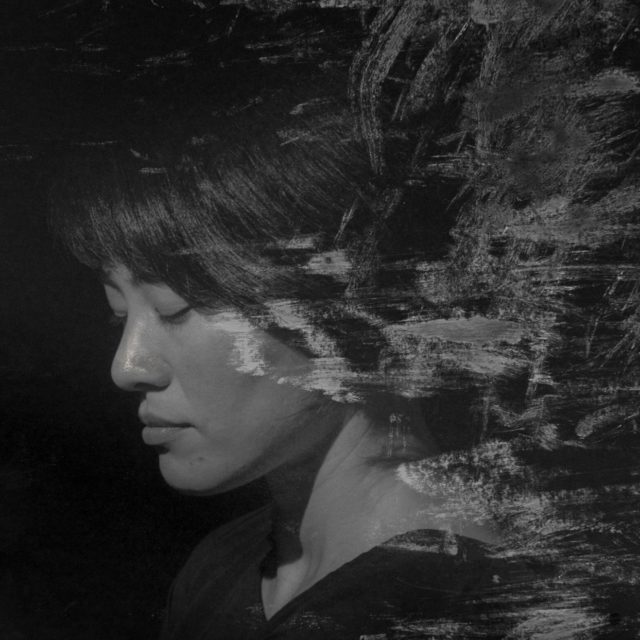
“Dopo il 2011 ho iniziato a fare foto per ricordare quello che era accaduto. Ho anche dovuto portare avanti l’attività di mio padre, non vedevo ancora la fotografia come un’arte.”
~ Quando hai capito, o sentito, la necessità di iniziare un progetto artistico personale su quello che era accaduto nella tua vita dopo la devastazione causata dallo tsunami?
Nel 2016, durante un workshop con Yumi Goto, fondatrice e curatrice della galleria Reminders Photography Stronghold. Lei ed altri partecipanti mi chiesero perché non raccontassi la mia storia, fu un suggerimento molto importante per me perché inizialmente volevo raccontare le storie di altre famiglie, non della mia. È stato quello il punto di svolta del mio progetto.
~ The Restoration Will è un progetto molto toccante. Dove hai trovato la forza e la determinazione di ricominciare, invece di cercare di dimenticare, e di confrontarti apertamente con i momenti più dolorosi che hanno cambiato per sempre la tua vita e quella di tante altre persone?
Non credo di aver ancora trovato quella forza. Durante il workshop con Yumi Goto a cui accennavo prima, ho imparato molte cose, non solo su come realizzare un photobook, ma anche cose legate a me stessa.
~ Come hanno reagito le persone, non solo gli amanti del libro fotografico o esperti, al tuo libro? Hai notato qualche differenza tra le reazioni di chi ha vissuto la tragedia e coloro che l’hanno vissuta solo attraverso i media?
Non ho trovato nessuna differenza fondamentale. Credo che tutti abbiamo vissuto un lutto o una tragedia simile nella nostra vita, indipendentemente dall’età. dalla nazionalità, dal genere. Per le vittime e i superstiti (parlo dei miei amici, dei vicini) a volte è troppo doloroso guardare il mio libro, ma tutti lo capiscono senza commentare. Sai, noi giapponesi siamo molto riservati, non parliamo molto delle tragedie tra di noi.
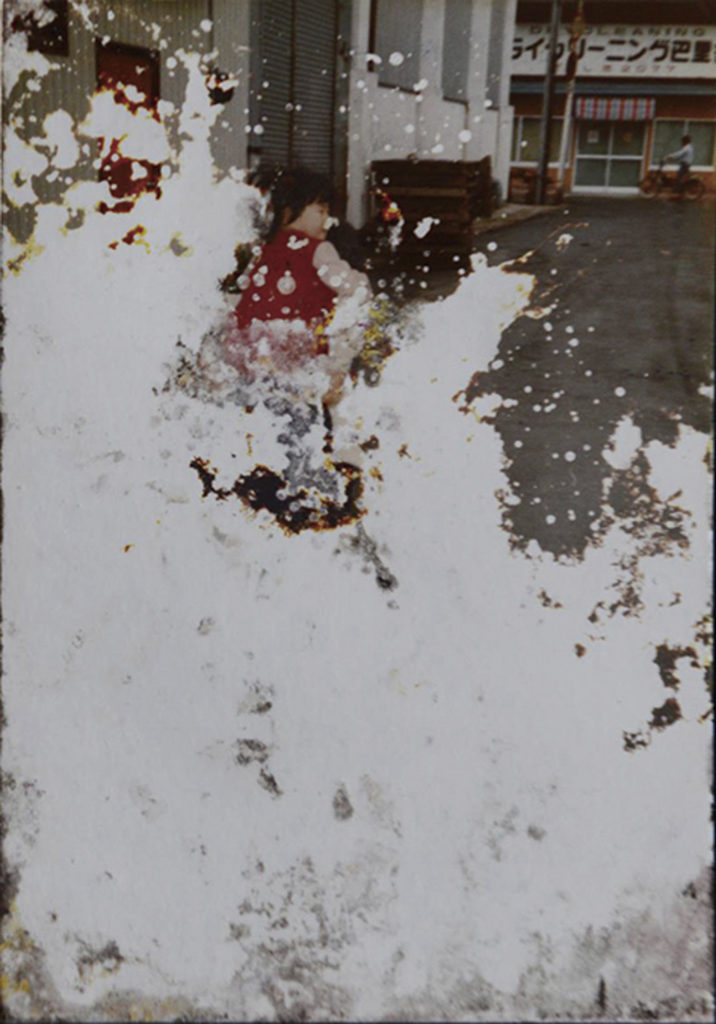
~ Come hai coinvolto nel progetto gli abitanti di Onagawa? Hai avuto qualche difficoltà?
Non è stato difficile. Quando mi servono persone in un paesaggio chiedo ai miei amici di fare da modelli. Ho sempre cercato di spiegare il mio progetto e quanto fosse importante partecipare. Per esempio “attraverso questo progetto NOI possiamo creare i ricordi futuri di Onagawa”.
Per esempio, alla fine del libro puoi trovare una mappa e una foto. Quando volti la pagina trovi la foto non danneggiata, ricostruita da me nel 2017. Le due ragazze non sono me e mia sorella! Sono le figlie del mio vicino. Ho mostrato loro la foto rovinata e ho detto: “Ricordate questa foto, vero? Mi aiuterete a ricostruire i ricordi in questo progetto?”. Questa azione è connessa anche alla ricostruzione della nuova comunità.
~ Quando hai iniziato il tuo progetto avevi già in mente di realizzare un libro? Com’è iniziata la tua passione per i fotolibri?
No, non avevo idea che ne sarebbe uscito un libro. Durante il workshop con Yumi ho iniziato a fare editing seguendo un linguaggio visivo per creare una narrazione che pian piano rivelasse la storia, ovvero il ritrovamento dello studio di mio padre.
“Ho iniziato a fare editing seguendo un linguaggio visivo per creare una narrazione che pian piano rivelasse la storia, ovvero il ritrovamento dello studio di mio padre.”
~ Come hai incontrato le meravigliose edizioni CEIBA?
A dire il vero due miei amici giapponesi avevano già pubblicato con ceiba editions. Entrambi i libri sono come oggetti, era il mio sogno lavorare con CEIBA. L’anno scorso (giugno 2017) si è tenuta una gara di fotolibri all’interno di Photolux (il premio Photoboox) sostenuta da CEIBA, e ho puntato a vincerla.
~ “The Restoration Will” racchiude il desiderio di parlare della perdita e la necessità di andare avanti ma senza dimenticare. Per questo è un progetto che parla a tutti con un linguaggio universale, perché ognuno di noi ha subito una perdita almeno una volta nella vita. Hai ricevuto qualche riscontro da persone che hanno avvertito questa dimensione universale e che hanno voluto condividere la loro esperienza con te?
Sì, mi ricordo in particolare una cosa che è successa a Lucca nel novembre 2017.
La famiglia veniva da Roma, ci siamo incontrati per strada durante Photolux. Hanno subito iniziato a parlare con me “Sei tu Suzuki? Abbiamo appena visto la tua mostra, è stata così toccante”, disse il padre. La figlia e la madre dissero “stavamo giusto parlando di quanto sia importante la famiglia”. Sono stati così dolci. Spero che la gente abbia deciso di parlare ai propri familiari, ai propri cari, agli amici dopo aver visto il mio lavoro.
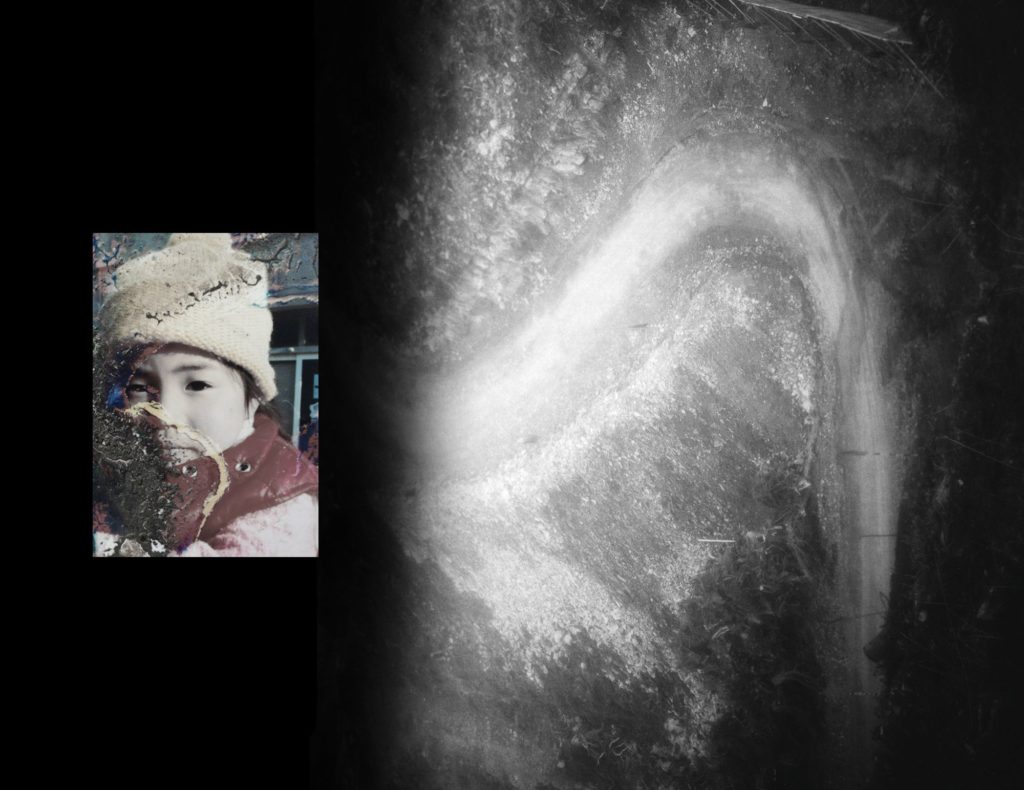

~ Su cosa stai lavorando al momento? Hai già nuovi progetti in mente oppure la tua mente è ancora focalizzata su “The Restoration Will”?
Ho iniziato un nuovo progetto sulla storia della mia città; ogni generazione ha vissuto una tragedia causata da uno tsunami. Sono curiosa di capire come mai la gente consideri “casa” una terra aspra e pericolosa per i suoi abitanti, e perché la gente continui a vivere lì, ogni volta ricostruendo la propria vita daccapo.
~ Nel tuo lavoro di ricerca continuerai a focalizzarti sulle conseguenze dello tsunami?
No, non credo. Lo tsunami è stato una causa scatenante, non il centro del mio lavoro. Preferisco concentrarmi sulla dignità umana e sulla vita dopo la morte, sull’aldilà.
1.Mayumi, let’s start by asking you how did your relationship with photography start.
-It is related to my background. My father and grandfather owned their photo studio to take portraits, anniversary family photos, wedding photos and so on. I have grown up watching their works. They made all customers happy. So I am very proud of their job.
Also, I was about 5 years old when my father started taking me into the darkroom and showed me the attractions of photography. I remember the moment when images floated up in the developer and the acidic smell. I was so enchanted by my father’s printing works I even forgot about mealtime.
After graduating at high school, I decided to go to photography college to learn photography as an education.
2.How would you define the photographer Mayumi before March 11, 2011, and the photographer Mayumi after March 11, 2011? Has anything changed in your personal artistic research after the tragedy of the tsunami?
-March 11, 2011 marks a turning point, I am totally different from who I was before. Before the tsunami, I had worked just as a business. You know, typical commercial works, portraits, my priority was to earn money. It was happy for me to have a conversation with customers. But there was no space for artistic work.
After 2011, I have started to take photos as a record. Also, I have taken over my father’s works which is making ‘graduation album’. I still had no idea on how to do any artistic work at that time. I was desperate to follow his works. In May 2011, I had a chance to exhibit at a gallery in New York as a volunteer member. It was the first time I had exhibited aboard. Many people could share my story, I felt a sense of responsibility like “I have to tell my story to the world”, so I decided to be a documentary photographer.
3.When did you understand, or feel, the necessity to start a personal artistic project on what happened to your life after the devastation caused by the tsunami?
-During a workshop with Yumi Goto (founder/curator of Reminders photography stronghold) in May 2016, She and other participants asked me “Why you don’t you tell own your story?”. This was a great suggestion for me. At first, I wanted to tell another’s family story and history, not mine. This was the good turning point of my project.
4.The Restoration Will is a very touching project. Where did you find the strength and the will to star over, rather than trying to forget, and to confront directly the most painful phases of what has changed in your life and in the life of many other people?
-I don’t think that I found the strength yet. The answer is same I have given in the previous question. I had learned many things in the workshop, not only about photobooks but also mental things.
5.How did people, not just photo book lovers or photo specialists, react to the book? Have you noticed any differences in the reactions of those who had directly lived the tragedy and those who had lived it only from far away?
-I’ve not found any remarkable difference.I think most people have grief or tragedy or similar thing, regardless of age, nationality, and gender. For victims/survivors (of course, they are my friends, neighbours) sometimes it seems too hard to watch my book, but they totally understand it without any comment. You know, most Japanese people are very quiet. We don’t talk too much about tragedies to each other.
6.How did you involve in the project the people living in Onagawa, if you’ve done so? Did you find any difficulty?
-It was not difficult. When I need subject on the landscape, I ask my friends top pose as models. I always tried to explain my project and tell the merit of joining it. For example, “Through this project, WE can make future memories of Onagawa together”. As an example, at the end of the book you can find a map and a snapshot.
When you turn turn the page, you can see the undamaged snap which I restored by myself in 2017, this is not an original photo. The two girls are not my sister and me! They are my neighbour’s daughters. I showed the damaged snap to them and asked “do you remember this street, right? Would you help me restore the memories of my project?” this action is also connected to rebuilding the new community.
7.Was “The Restoration Will” already a book in your mind when you started the project? How did your passion for photobooks start?
-No, I didn’t have any idea of how “The Restoration Will” would turn out. During Yumi’s workshop, I tried to edit photos as a visual language, to make a narrative, to have a clear picture of the story little by little, I wanted to recall the existence of photo studio on my book.
8.How did you meet the wonderful ceiba editions?
-Actually, my two Japanese friends had been published by Ceiba editions before. Both books are as objects. So I was dreaming to work with Ceiba. Last year (in June 2017), there was photobook competition in Photolux (the name is Photoboox), supported by Ceiba, so I aimed to win it.
9.The Restoration will contains the will to talk about loss and the need to go on without forgetting, and it is, therefore, a project that talks to everybody with a universal language, because everyone has, at any title, experienced a loss at some point of his/her life. Did you receive any feedback from people who felt this universal meaning and shared his/her personal experience with you?
-Of course, I remember one good feedback in Lucca on November 2017.
The family came from Rome, we met on the street during photolux. They talked to me suddenly ” Are you Suzuki? We just watched your exhibition! It was so emotional”, the father said. And daughter and mother said, ” we are talking about how much importance of family”. They were so lovely. I hope the people tried to talk to family, loved ones, close friends, after watching.
10.What are you working on right now? Are you already working on a new future project or is your mind still on The Restoration Will?
-I’ve started my new project about the history of my town. Each generation has a disaster caused by the tsunami. My curiosity is why people are so strongly connected to a homeland that is rough on and even dangerous for its people and what makes people stay and rebuild their lives over and over again.
11.Will you keep reflecting on the consequences of the tsunami in your personal work?
– Not really. The tsunami is my trigger, not a core of my interest. I prefer to human dignity or the afterlife (afterworld?).
- Posted by Laura De Marco
- On 8 Marzo 2018
- 0 Comment

